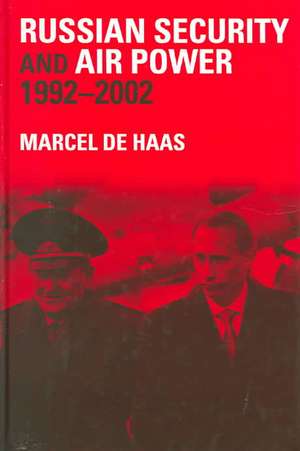Russian Security and Air Power, 1992-2002: Soviet (Russian) Military Theory and Practice
Autor Marcel De Haasen Limba Engleză Hardback – 12 aug 2004
It describes military and political decision-making from Moscow's grand strategy to the use of a single fighter aircraft in Chechnya. In this analysis, Russia's air forces are used as a model for all services of the armed forces.
The Chechen conflicts and NATO's security policy have been dominant factors in the development of Russia's security policy during the period 1992-2002. The use of air power in the Chechen conflicts is used here as a case study for testing political and military-strategic objectives. With regard to NATO's security policy, this study shows that the eastward enlargement of this alliance, as well as its use of force in Bosnia and Kosovo, have caused an increase in anti-Western tendencies in Russian security thinking.
Preț: 791.37 lei
Preț vechi: 1102.41 lei
-28% Nou
Puncte Express: 1187
Preț estimativ în valută:
151.48€ • 164.59$ • 127.32£
151.48€ • 164.59$ • 127.32£
Comandă specială
Livrare economică 31 martie-14 aprilie
Doresc să fiu notificat când acest titlu va fi disponibil:
Se trimite...
Preluare comenzi: 021 569.72.76
Specificații
ISBN-13: 9780714656083
ISBN-10: 0714656089
Pagini: 260
Dimensiuni: 156 x 234 x 16 mm
Greutate: 0.42 kg
Ediția:New.
Editura: Taylor & Francis
Colecția Routledge
Seria Soviet (Russian) Military Theory and Practice
Locul publicării:Oxford, United Kingdom
ISBN-10: 0714656089
Pagini: 260
Dimensiuni: 156 x 234 x 16 mm
Greutate: 0.42 kg
Ediția:New.
Editura: Taylor & Francis
Colecția Routledge
Seria Soviet (Russian) Military Theory and Practice
Locul publicării:Oxford, United Kingdom
Public țintă
General, Postgraduate, Professional, and UndergraduateCuprins
Part 1: Structure of Security Policy 1. Introduction 2. Organs of National Security 3. Persons Involved in National Security 4. Military Power 5. Influence of Actors on Security Policy Part 2: Implementation of Security Policy 1. Introduction 2.Russian Military Conceptual Thought 3. National Security Concept 4. Foreign Policy 5. Military Doctrine 6. Putin's Security Policy: A comparison of the 2000 issues of the National Security Concept, Military Doctrine, and Foreign Policy Concept 7. Conclusions: Consistency of RF Security Part 3: Structure of Airpower 1. Introduction 2. Organization of the VVS 3. Combat Readiness 4. Reforms and Reorganizations 5. Thoughts on the Use of Airpower Part 4: Implementation of Airpower: War around Chechnya 1. Introduction 2. The first Chechen Conflict (1994-1996) 3. The Conflict in Dagestan (August-September 1999) 4. The Second Chechen Conflict (October 1999-) 5.Assessment: Comparison of the use of airpower in the Chechen conflicts Part 6: Conclusions and Assessment 1. Conclusions 2. Validity 3. Further Developments and Outlook
Notă biografică
Marcel de Haas is an officer in the Royal Netherlands Air Force. Since September 2003 he has been posted at the NATO School, Oberammergau, Germany as Head of the Research Branch. He completed his MA in Russian Studies at Leiden University (1987) on 'Soviet Policy Towards Southern Africa' and his PhD at Amsterdam University (2004) on 'Russian Security Policy and Air Power 1992-2002'. He has published some 50 articles on Soviet, CIS and Russian security developments in the Journal of Slavic Military Studies, RAF Air Power Review and Officer magazine as well as in Dutch military-political journals. As an arms control inspector he has visited Russia and Belarus.
Recenzii
'A very well researched analysis of, and reference to, the development of Russian political and military thought in the immediate post-Cold War era.' - RAF Air Power Review
'De Haas has written a book of great interest for anyone concerned with Russian security and defence policy … Is worthy in itself and very usable as a platform for further empirical studies.’ – Baltic Security and Defence Review
'De Haas has written a book of great interest for anyone concerned with Russian security and defence policy … Is worthy in itself and very usable as a platform for further empirical studies.’ – Baltic Security and Defence Review
Descriere
This book analyses the security policy of the Russian Federation, internally as well as externally, on all levels of strategy from 1992-2002.









